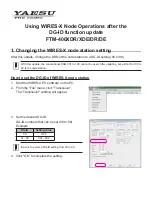
CPT6010 Operating Instructions
9
Digital Pressure Transducer
CPT6010
3. Product Description
3.1 General Description
The CPT6010 Digital Pressure Transducer (CPT6010) is a self-contained pressure sensing device
that provides high accuracy pressure measurements. This transducer incorporates a low hysteresis
silicon sensor with electronically compensated pressure linearity over the specified temperature
range. Communication with the CPT6010 is over a serial bus, either RS-232 or RS-485.
One end of the CPT6010 has a 1/4” NPT male fitting pressure port, and the opposite end has a six
pin power/signal connector (J1) and a #10-32 reference pressure port (for gauge pressure only).
(See Figure 5.2 - Outline drawing)
3.2 Turndowns
The transducer has the capability to include two distinct ranges (turndowns) using a single sensor.
The primary turndown is always the higher range of the transducer. The second turndown has ex-
actly the same performance specifications, but at some lower full scale range which is not less than
half the primary turndown range. At powerup the primary turndown is active by default.
3.3 Power Supply
The required 9-18 VDC power enters the CPT6010 via J1. All of the transducer electronics and
communications share a common ground.
3.4 Sensor
The pressure sensor is secured to the transducer case and the 1/4 NPT fitting. The case includes a
#10-32 threaded opening which is the reference pressure port for gauge, vacuum or bi-directional
type sensors.
3.5 Circuitry
All of the circuitry for the CPT6010 is included on a single PC board. The combined pressure and
temperature sensor signals are routed to the signal conditioning electronics.
3.6 Serial In/Out Communications
The serial bus is set to either RS-232 or RS-485 at the factory. The bus is a two-way communica-
tion path used to receive commands and return measured pressure values and other transducer
information to the user. This port is also used to transmit calibration adjustments and other user
functions to the CPT6010. Pressure units for each transducer are specified by the customer. Wiring
requirements for the serial port are provided in section 5, Installation, and a list of valid commands
and responses (see Table 6.4.4 - Commands and Queries) is provided in section 6, Operation.










































